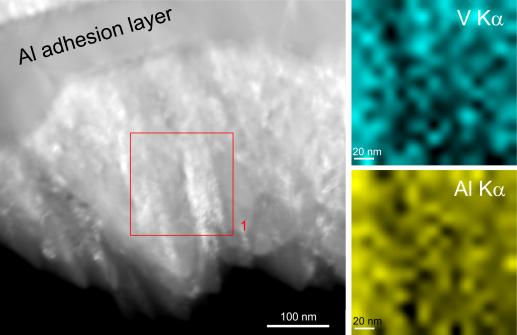Protective coatings for cutting tools have been dominated by titanium nitride (TiN) based alloy coatings, among which TiAlN coatings are most favored due to their high hardness (>30 GPa), good oxidation resistance, and especially age hardening at high service temperatures. However, these Ti-containing coatings suffer from a relatively high coefficient of friction, which leads to a high cutting force and poor surface finish, thereby limiting their use in dry cutting of conventional alloys or hard-to-machine Ti and Ni alloys.
Vanadium nitride (VN) coatings, which have been used as a component in multilayered nitride coatings (such as TiAlN/VN) and as multicomponent solid solutions (such as TiAlVN, AlCrVN), have exhibited distinct improvement in cutting tests. Their low hardness (<20 GPa) and poor oxidation resistance, however, made them unsuited for independent use.
Recently, a research group led by Professor Feng Huang at the Ningbo Institute of Materials Technology & Engineering (NIMTE),the Chinese Academy of Sciences (CAS), has significantly improved the hardness of magnetron sputtered VN coatings by alloying with AlN. Specifically, using a reactive magnetron co-sputtering process in which elemental vanadium (V) and aluminum (Al) were separately driven by dc and pulsed-dc power supplies, they obtained a series of metastable V1−xAlxN coatings with various AlN contents (x = 0–0.62). A relatively high hardness (>30 GPa) was found in the V1−xAlxN coatings with 0.48 ≤ x ≤ 0.57. These coatings were cubic only and contained no detrimental hexagonal AlN phase. Compositional fluctuations were found, suggesting that the high hardness can be attributed to presence of the interconnected AlN-rich and AlN-deficient domains.
The results have been published on Surf. Coat. Technol. [Volume 232,15 October 2013, Page 311-318] with a Chinese patent pending.
Vanadium nitride (VN) coatings, which have been used as a component in multilayered nitride coatings (such as TiAlN/VN) and as multicomponent solid solutions (such as TiAlVN, AlCrVN), have exhibited distinct improvement in cutting tests. Their low hardness (<20 GPa) and poor oxidation resistance, however, made them unsuited for independent use.
Recently, a research group led by Professor Feng Huang at the Ningbo Institute of Materials Technology & Engineering (NIMTE),the Chinese Academy of Sciences (CAS), has significantly improved the hardness of magnetron sputtered VN coatings by alloying with AlN. Specifically, using a reactive magnetron co-sputtering process in which elemental vanadium (V) and aluminum (Al) were separately driven by dc and pulsed-dc power supplies, they obtained a series of metastable V1−xAlxN coatings with various AlN contents (x = 0–0.62). A relatively high hardness (>30 GPa) was found in the V1−xAlxN coatings with 0.48 ≤ x ≤ 0.57. These coatings were cubic only and contained no detrimental hexagonal AlN phase. Compositional fluctuations were found, suggesting that the high hardness can be attributed to presence of the interconnected AlN-rich and AlN-deficient domains.
The results have been published on Surf. Coat. Technol. [Volume 232,15 October 2013, Page 311-318] with a Chinese patent pending.

Fig. 1 Hardness (H) and indentation modulus (E*) of V1?xAlxN coatings
|
|
Fig. 2 Z-contrast STEM image of the V0.38Al0.62N coating and two STEM–EDX elemental maps (V Kα and Al Kα) of the square area marked on the image
Prof. Feng Huang huangfeng@nimte.ac.cn
Research Group Url:http://english.nimte.cas.cn/rh/rd/sf/sf_research_interests/
All images by 


